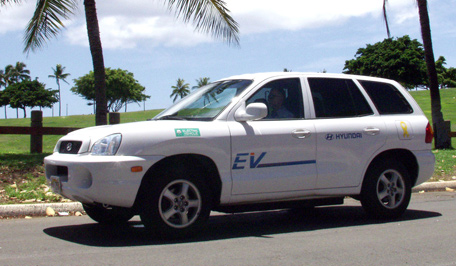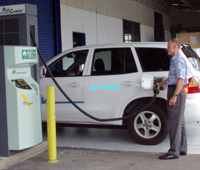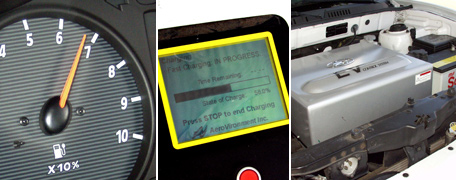
Back in the early 1990s, it was evident that battery electric vehicles would face multiple challenges on their way to the mass market. Battery technology hadn't advanced to the point where many had hoped it would be. Cost remained high and the single-charge driving range provided by even the most advanced battery technologies was inadequate, at least in the minds of most drivers.

But there were multiple tracks being explored to overcome this. Battery companies and automakers alike continued to work toward creating better and more advanced battery technologies. This work continues to this day at companies like Cobasys, Panasonic EV Energy, and others where enormous effort is devoted to bringing high efficiency, power dense, and more environmentally benign batteries to the market. Better batteries, however, have represented but one thrust in recent years aimed at overcoming driving range and battery cost issues.

One of the great hopes of the past decade was rapid charging, a simple concept that would find public and home chargers capable of renewing an electric vehicle's batteries in 10 to 20 minutes rather than the usual six to eight hours. With the advent of rapid charging, it was anticipated that limited single-charge driving range would no longer be an obstacle to electric vehicle ownership. After all, if a driver reached a vehicle's end-of-charge after 80 or 120 miles but could quickly renew the car's batteries during a quick-charge session at a convenience store, fast food restaurant, or coffee shop, what's the downside?
In this time frame, Chrysler went so far as to stage a cross country demonstration of quick charging using its Dodge Caravan-based EPIC (Electric Power Intra-urban Commuter) electric minivan, with a conventional van hauling a rapid charger along to handle the job. It wasn't elegant, but it got the point across.
So, then...whatever became of the intense interest that was once focused on rapid chargers? This is a question that Tom Quinn, director of the Hawaii Center for Advanced Transportation Technologies (HCATT), often ponders. His organization, which spun off from the Hawaii Electric Vehicle Demonstration Program that's been running since 1993, has been field testing AeroVironment PosiCharge rapid chargers for the past several years. During this time, these chargers have been servicing a fleet of Hyundai Santa Fe battery electric vehicles, along with an array of pickup trucks, buses, and airport trams modified to run on electric power.
The Hawaii demonstration program went to great lengths to provide rapid charging opportunities for EVs, installing 11 rapid charge stations around the island of Oahu. As in the movie Field of Dreams, operators of the demonstration program figured that if they built them (chargers), they (electric vehicles) would come. And they should have, because convincing anyone to build infrastructure ahead of the advanced technology vehicles that will use it is the hard part.
Ultimately, the lone automaker to step up was Hyundai, which fielded a fleet of advanced Santa Fe electric vehicles featuring an 80 horsepower (60 kW) electric motor powered by a nickel-metal-hydride (NiMH) battery pack. The electrically motivated SUV can be driven about 100 miles between charges, which are handled by a 6.6 kW on-board charger or an off-board rapid charger that connects to a 25 kW-capable charging inlet behind the vehicle's standard fuel filler door. Beneath the hood is a motor control box with a DC/DC converter, charger, and motor controller.

We had the opportunity to put this vehicle to the test, both on the roads of Oahu and at the end of a charging connection at one of the public 60 kW PosiCharge units scattered around the island. Behind the wheel, the electric Santa Fe performed well and transported us amid palm tree-lined streets confidently and comfortably. While acceleration specs are somewhat sedate for an SUV with a 0-60 mph time of about 19 seconds, daily driving needs are well accommodated and we didn't consider this an issue.
Our real surprise occurred while charging. Even though Hyundais fast-charge requirements call for a less powerful and somewhat slower rapid charge experience for the vehicle's NiMH batteries due to temperature constraints, a full charging session took about 30 minutes start-to-finish. That's longer than the 10-15 minute rapid charge available at full power, which lead-acid battery EVs often take advantage of on Oahu, but worlds apart from the six hour overnight charging regimen we followed during our year-long test of a GM EV1.
Along with Hyundai, electric vehicle drivetrain firm Enova Systems has also been involved in the demonstration program by upfitting cars, pickups, and shuttle buses to electric drive on the island. The Hawaiian Electric Company, which was contracted to install most of the rapid chargers, has also been a strong participant and viewed the program as an opportunity to grow its EV fleet.
An interesting thing occurred once the charging network was established. The rapid chargers virtually doubled the usefulness of the electric vehicles operating in various fleets due to less down time. Prior to rapid charging, operators would use their EVs during the morning hours and then plug them in for the rest of the day using their on-board chargers. This quickly changed for the better with rapid chargers allowing drivers to charge their trucks while eating lunch and then head off with a full charge for an afternoon's activities.
With an initial two years of rapid testing completed and an extension through 2005 now in place from Hyundai and the State of Hawaiis High Technology Development Corporation, Oahus very successful rapid-charge demonstration continues. Hopefully, other automakers will recognize the value of this program and join in to further explore the viability of battery electric vehicles in a rapid charge environment.
( Source : Yahoo )

Editor : Kereta elektrik memang jimat tapi sekiranya tidak disokong oleh usaha melengkapkan prasarana yang cukup dan perkembangan teknologinya dalam negara lambat, ia hanya akan menyusahkan pengguna. Jadilah pengguna dan pembeli yang bijak.































0 ulasan:
Catat Ulasan